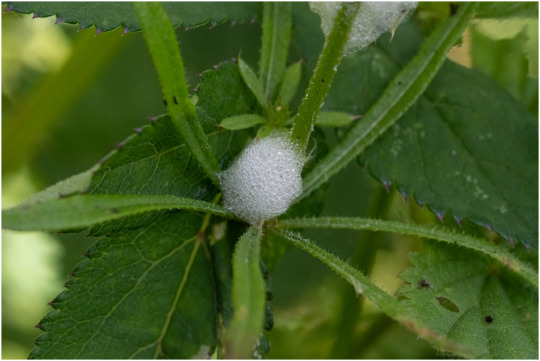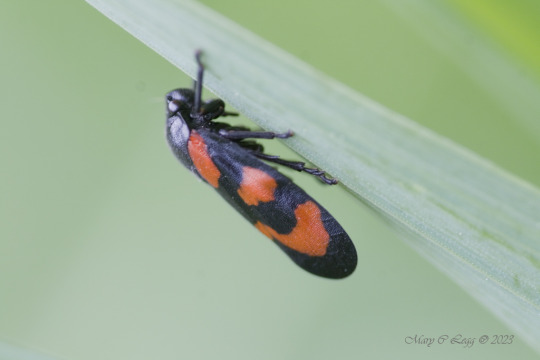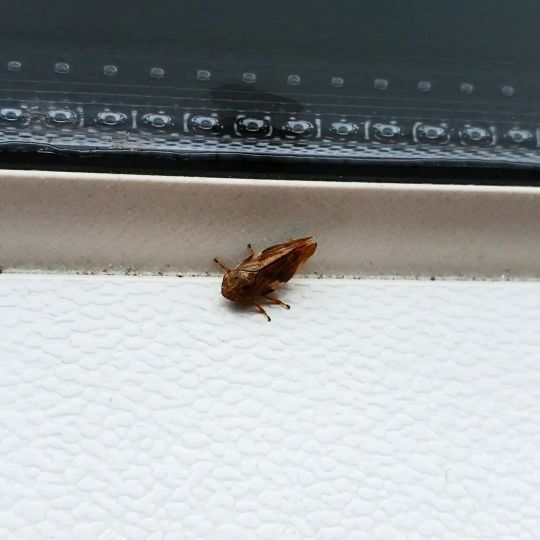#Aphrophoridae
Text

if you've ever touched a plant and got a handful of gross dish soap you can blame the children of a spittlebug like this one (Philaenus sp.). while the adults mostly just stand around looking like little seeds, as nymphs they protect themselves with foam made from the excess of the actual sap they feed on

here is some. the nymphs are understandably hard to photograph since they're hidden in there, although occasionally you can see them peeking out. the foam is known as cuckoo spit, presumably because both spittlebugs and cuckoos begin to appear at the same time throughout most of the holarctic, sometime in early to mid spring. over here they're not in sync, so the name doesn't work as well - this photo was taken in early february, long before any cuckoos showed up
4 notes
·
View notes
Text

Skumcikade (Aphrophoridae indet.)
Nymfe-skjul.
Spittlebug (Aphrophoridae indet.)
Nymph hide.
#Skumcikade#Skumcikade Aphrophoridae indet.#Aphrophoridae#Spittlebug#Næbmunde#Hemiptera#Insekt#Insect#Topbjerg#Sommer#Summer#Field#Mark
2 notes
·
View notes
Text

Ausländische Zirpen | Alfred Edmund Brehm | Die Insekten, Tausendfüssler und Spinnen (1877) | Flickr
#alfred edmund brehm#vintage illustration#chromolithographie#zirpen#ledra aurita#cercopis fabricius#aphrophoridae
1 note
·
View note
Text

Red and Black Froghopper, Cercopis sanguinolenta Canon 400D EF 100 2.8 f/3.2 1/160 iso: 400 Srbsko, Czech Republic 5/22/2010
#Froghoppers#Spitbugs#spittlebugs#Aphrophoridae#Cercopis#insects#invertebrates#macro#grasslands#pests#insect#macrophotography#insectphotography#canon
0 notes
Text


Staring at plants is so rewarding
1 note
·
View note
Photo

tiny frog hopper on my plate. Philaenus spumarius Common Froghopper
Family: Aphrophoridae
0 notes
Text
Summer Spittlebugs
This time of year it’s not unusual to be walking through a garden or meadow and suddenly come across what looks like a wad of spit or foam stuck to the stem of a plant. This wasn’t left by some uncouth person, nor is it the remnants of some pesticide or other chemical. Instead, it’s the active shelter of a spittlebug!

As the name suggests, these insects create these foamy conglomerations. They then use them as shelter while they feed on the sap of the host plant. There are literally thousands of species within the superfamily Cercopoidea, consisting of the three families Aphrophoridae, Cercopidae, and Clastopteridae. They’re also colloquially known as froghoppers, though the nymph stage that is found within the spit doesn’t yet hop.
The spit protects the nymphs in a few ways. It’s a visual cover to keep predators from seeing them. If a predator should try to eat the spit, nymph and all, it will find that the foam has a rather awful taste. And it can offer some protection from heat and sunlight on hot summer days. It’s made of waste material from digested sap; one nymph can cycle three hundred times its body weight in sap through its system in one hour.
While sap isn’t exactly a calorie-dense food, spittlebug nymphs have secret allies that were only recently discovered. It turns out that they have not one but two species of bacteria living in their digestive systems. In a symbiotic relationship, the bacteria take shelter there while helping the spittlebug acquire extra nutrition. How? By turning glucose from the sap into crucial amino acids that the nymph needs. Other insects that survive on sap also have these sorts of bacteria, but only one species each rather than two.
Adult spittlebugs are also pretty remarkable. They’re even better jumpers than fleas considering their larger size. Some still retain aposematic coloration that warns away predators. And while they may only live a few weeks after molting into their adult form, the females of some species can lay several dozen eggs before she dies.

Here’s the thing: the vast majority of spittlebugs aren’t going to seriously harm your plants. They don’t take enough sap, and aren’t going to hide in their foamy homes long enough to be a concern. If you have a LOT of them on one plant, they may cause a bit of distortion of the plant’s tissues, temporarily weaken its immune system or open it to diseases through the wounds, but this is a rare situation. And the spittlebug species that don’t produce bad-tasting secretions are potential food for other animals, so they do have an ecological role to play.
Occasionally species like the meadow spittlebug (Philaenus spumarius) may carry the bacteria Xylella fastidiosa which can cause widespread diseases in agricultural crops like Pierce’s disease or olive quick decline syndrome. But the plants in your garden are not likely to suffer the same fate, especially if you’re growing a nice variety of species rather than an entire plantation of one thing.
Finally, I want to advocate for biodiversity rather than the kneejerk reaction “It’s a bug on my plant–kill it!”. You want bugs in your garden (especially native species), because that means it’s an active ecosystem that supports local life. If you determine that you have a non-native species like the aforementioned meadow spittlebug, then all you need to do to get rid of it is hose down the affected plants as needed; pesticides won’t penetrate through the spit anyway, and a hose is faster, cheaper, and safer. Otherwise, native species of spittlebug are not going to cause you any issues, will be gone in a few weeks, and have a place in their ecosystem, too. So enjoy the fact that you’ve created a good home for wildlife, and marvel at these insects with a rather unique strategy for survival!
Did you enjoy this post? Consider taking one of my online foraging and natural history classes, checking out my other articles, or picking up a paperback or ebook I’ve written! You can even buy me a coffee here!
#spittlebugs#froghoppers#spit bugs#insects#bugs#invertebrates#wildlife#animals#nature#gardening#food web#ecology#ecosystem#scicomm#science communication#biology#science
93 notes
·
View notes
Text



Family Aphrophoridae - Typical Spittlebugs- Probably a Round-Headed Spittlebug. Apologies for photos but it was so small my camera pretty much laughed at me.
1 note
·
View note
Text
Une nouvelle espèce d'un nouveau genre vient d'être décrite dans la super-famille des Cercopoidea (dont fait partie la famille des cercopes), Araeoanasillus leptosomus gen. et sp. nov., à partir de...
See on Scoop.it - EntomoNews
Araeoanasillus leptosomus gen. et sp. nov., (Hemiptera, Cercopoidea, Sinoalidae?), a New Froghopper from Mid-Cretaceous Burmese Amber with Evidence of Its Possible Host Plant
by George Poinar, Jr.
Department of Integrative Biology, Oregon State University,
Life
Published: 31 March 2023
(This article belongs to the Special Issue Recent Research on Palaeontology)
[Image] Holotype of Araeoanasillus leptosomus gen. et sp. n. in Burmese amber. (A)—dorsal view; (B)—ventral view; (C)—lateral view. Arrowhead shows tip of abdomen. Scale bar for (A,C) = 1.0 mm; for (B) = 1.3 mm.
-------
NDÉ
D'après l'étude
Une nouvelle espèce d'un nouveau genre vient d'être décrite dans la super-famille des Cercopoidea (dont fait partie la famille des cercopes), Araeoanasillus leptosomus gen. et sp. nov., à partir de l'ambre birman du Crétacé moyen.
La superfamille des Cercopoidea — proche parente de celle qui inclut les cicadelles et de celle qui inclut les membracides — comprend actuellement cinq familles existantes (Aphrophoridae Amyot et Serville, 1843 ; Cercopidae Leach, 1815 ; Clastopteridae Dohrn, 1859 ; Epipygidae Hamilton, 2001 ; et Machaerotidae Stal, 1866) et trois familles éteintes (Cercopionidae Hamilton, 1990 ; Procercopidae Handlirsch, 1906 ; et Sinoalidae Wang et Szwedo, 2012) [1,2].
Le nouveau genre Araeoanasillus possède les caractéristiques suivantes : corps mince, de taille moyenne (longueur 7 mm) avec tête plus longue que large, yeux ronds ; antennes minces avec huit antennomères ; pédicelle très court, plus court que le scape ; pronotum avec un rapport longueur/largeur de 2. 4 ; métatibia avec trois épines, dont une épine courte près de la base et deux épines adjacentes, longues et épaisses près de l'apex ; une seule série de 16 dents apicales épaisses (peigne) à l'apex métatibial ; [...]
Les membres existants des Cercopoidea, ont deux types de comportement au cours de leur développement. Alors que les nymphes, dénommées "spittlebugs" en anglais, produisent de l'écume et se nourrissent dans cette masse de bave mousseuse — que l'on appelle le « crachat de coucou » — qui masque leur présence, les adultes ailés, appelés en anglais "froghoppers", n'ont pas cette protection.
Bien que nous ne sachions rien de la biologie des individus de cette famille éteinte (préférences alimentaires, comportements de recherche de nourriture, parasites, capacité des nymphes à produire de l'écume au cours de leur développement), le présent spécimen nous donne des indices sur son hôte végétal possible. Les trichomes végétaux uniques adjacents et attachés au fossile suggèrent que le "cercope" s'est nourri et a probablement pondu sur des fougères.
0 notes
Photo

Taken 2022 31st August, this was a European alder spittle bug (Aphrophora alni) I found on the bus. In Sweden, they occur wherever forest edges, hedgerows, meadows, gardens, and parks are present. Contrary to their name, these spittle bugs don't only feed from alder trees as bushes and trees of different species are also taken, with adults prefer deciduous trees while larvae prefer herbaceous plants. They can be seen from May-October, with their life-cycle beginning in spring hatching from eggs laid close to winter. The nymphs live on the stems and leaves of herbaceous plants protected from exposure by a foam made from plant sap until they've reached their imago stage. Eventually, females will mate and will deposit her eggs on herbaceous plants close to winter, where they overwinter until the following spring starting the cycle over. #animal #animals #djur #natur #naturliv #wildlife #insect #insects #insekt #insekter #nature #spittlebug #spittlebugs #bugs #bug #arthropod #arthropods #invertebrate #invertebrates #truebug #truebugs #insectagram #animalia #arthropoda #insecta #hemiptera #aphrophoridae #aphrophora #aphrophoraalni #europeanalderspittlebug https://www.instagram.com/p/CnSQ_p7Kw_T/?igshid=NGJjMDIxMWI=
#animal#animals#djur#natur#naturliv#wildlife#insect#insects#insekt#insekter#nature#spittlebug#spittlebugs#bugs#bug#arthropod#arthropods#invertebrate#invertebrates#truebug#truebugs#insectagram#animalia#arthropoda#insecta#hemiptera#aphrophoridae#aphrophora#aphrophoraalni#europeanalderspittlebug
0 notes
Photo

Spittlebug (Philagra sp., Aphrophoridae)
by Sinobug (itchydogimages) on Flickr.
Pu’er, Yunnan, China
See more Chinese true bugs and hoppers on my Flickr site HERE...
#insect#macro#China#Yunnan#itchydogimages#Sinobug#entomology#bug#hopper#spittlebug#Hemiptera#Aphrophoridae
279 notes
·
View notes
Photo

14 notes
·
View notes
Video
Froghopper, Aphrophoridae by Andreas Kay
Via Flickr:
from Ecuador: www.flickr.com/andreaskay/albums
21 notes
·
View notes
Text
A small child under the care of Anthia. She's very innocent and has an interest in seafare.

1 note
·
View note
Photo

Another old photo I found of an Aphrophoridae specimen
2 notes
·
View notes
Photo

bubbles
aphrophoridae
139 notes
·
View notes
